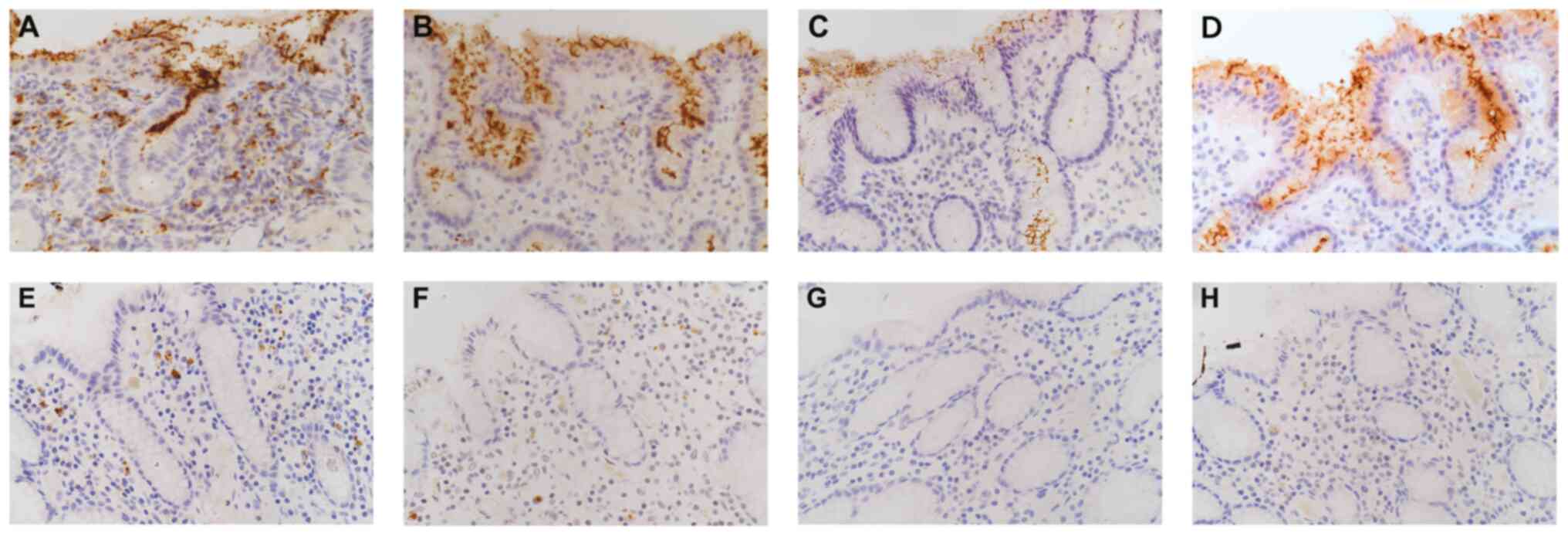|
1
|
Li Y, Choi H, Leung K, Jiang F, Graham DY
and Leung WK: Global prevalence of Helicobacter pylori
infection between 1980 and 2022: A systematic review and
meta-analysis. Lancet Gastroenterol Hepatol. 8:553–564.
2023.PubMed/NCBI View Article : Google Scholar
|
|
2
|
Marshall B: Helicobacter pylori-a
nobel pursuit? Can J Gastroenterol. 22:895–896. 2008.PubMed/NCBI View Article : Google Scholar
|
|
3
|
Malfertheiner P, Camargo MC, El-Omar E,
Liou JM, Peek R, Schulz C, Smith SI and Suerbaum S: Helicobacter
pylori infection. Nat Rev Dis Primers. 9(19)2023.PubMed/NCBI View Article : Google Scholar
|
|
4
|
Gasbarrini G and Bonvicini F: Interaction
between Helicobacter pylori and human gastric mucosa
revisited by electron microscopy: Still something new to debate?
Eur Rev Med Pharmacol Sci. 22:5312–5316. 2018.PubMed/NCBI View Article : Google Scholar
|
|
5
|
Chauhan M, Nahar J, Zafar Y and
El-Halawany H: Acute gastroenteritis revealing Helicobacter
bacteremia: How common is this? Am J Gastroenterol. 113
(Suppl)(S1392)2018.
|
|
6
|
Dudley J, Wieczorek T, Selig M, Cheung H,
Shen J, Odze R, Deshpande V and Zukerberg L: Clinicopathological
characteristics of invasive gastric Helicobacter pylori. Hum
Pathol. 61:19–25. 2017.PubMed/NCBI View Article : Google Scholar
|
|
7
|
Huang Y, Wang QL, Cheng DD, Xu WT and Lu
NH: Adhesion and invasion of gastric mucosa epithelial cells by
Helicobacter pylori. Front Cell Infect Microbiol.
6(159)2016.PubMed/NCBI View Article : Google Scholar
|
|
8
|
Ito T, Kobayashi D, Uchida K, Takemura T,
Nagaoka S, Kobayashi I, Yokoyama T, Ishige I, Ishige Y, Ishida N,
et al: Helicobacter pylori invades the gastric mucosa and
translocates to the gastric lymph nodes. Lab Invest. 88:664–681.
2008.PubMed/NCBI View Article : Google Scholar
|
|
9
|
Scott DR, Sachs G and Marcus EA: The role
of acid inhibition in Helicobacter pylori eradication.
F1000Res 5: F1000 Faculty Rev-1747, 2016.
|
|
10
|
Siavoshi F, Saniee P, Khalili-Samani S,
Hosseini F, Malakutikhah F, Mamivand M, Shahreza S and Sharifi AH:
Evaluation of methods for H. pylori detection in PPI
consumption using culture, rapid urease test and smear examination.
Ann Transl Med. 3(11)2015.PubMed/NCBI View Article : Google Scholar
|
|
11
|
Saniee P, Shahreza S and Siavoshi F:
Negative effect of proton-pump inhibitors (PPIs) on Helicobacter
pylori growth, morphology, and urease test and recovery after
PPI removal-an in vitro study. Helicobacter. 21:143–152.
2016.PubMed/NCBI View Article : Google Scholar
|
|
12
|
Malfertheiner P, Megraud F, O'Morain CA,
Gisbert JP, Kuipers EJ, Axon AT, Bazzoli F, Gasbarrini A, Atherton
J, Graham DY, et al: Management of Helicobacter pylori
infection-the maastricht V/florence consensus report. Gut. 66:6–30.
2017.PubMed/NCBI View Article : Google Scholar
|
|
13
|
Sarem M and Corti R: Role of
Helicobacter pylori coccoid forms in infection and
recrudescence. Gastroenterol Hepatol. 39:28–35. 2016.PubMed/NCBI View Article : Google Scholar : (In Spanish).
|
|
14
|
Ierardi E, Losurdo G, Mileti A, Paolillo
R, Giorgio F, Principi M and Di Leo A: The puzzle of coccoid forms
of Helicobacter pylori: Beyond basic science. Antibiotics
(Basel). 9(293)2020.PubMed/NCBI View Article : Google Scholar
|
|
15
|
Gladyshev N, Taame M and Kravtsov V:
Clinical and laboratory importance of detecting Helicobacter
pylori coccoid forms for the selection of treatment. Prz
Gastroenterol. 15:294–300. 2020.PubMed/NCBI View Article : Google Scholar
|
|
16
|
Krzyżek P and Grande R: Transformation of
Helicobacter pylori into coccoid forms as a challenge for
research determining activity of antimicrobial substances.
Pathogens. 9(184)2020.PubMed/NCBI View Article : Google Scholar
|
|
17
|
Rupp S, Papaefthymiou A, Chatzimichael E,
Polyzos SA, Spreitzer S, Doulberis M, Kuntzen T and Kountouras J:
Diagnostic approach to Helicobacter pylori-related gastric
oncogenesis. Ann Gastroenterol. 35:333–344. 2022.PubMed/NCBI View Article : Google Scholar
|
|
18
|
Heilmann KL and Borchard F: Gastritis due
to spiral shaped bacteria other than Helicobacter pylori:
Clinical, histological, and ultrastructural findings. Gut.
32:137–140. 1991.PubMed/NCBI View Article : Google Scholar
|
|
19
|
Dixon MF, Genta RM, Yardley JH and Correa
P: Classification and grading of gastritis. The updated sydney
system. International workshop on the histopathology of gastritis,
Houston 1994. Am J Surg Pathol. 20:1161–1181. 1996.PubMed/NCBI View Article : Google Scholar
|
|
20
|
Uchida T, Miftahussurur M, Pittayanon R,
Vilaichone RK, Wisedopas N, Ratanachu-Ek T, Kishida T, Moriyama M,
Yamaoka Y and Mahachai V: Helicobacter pylori infection in
Thailand: A nationwide study of the CagA phenotype. PLoS One.
10(e0136775)2015.PubMed/NCBI View Article : Google Scholar
|
|
21
|
Chen YC, Malfertheiner P, Yu HT, Kuo CL,
Chang YY, Meng FT, Wu YX, Hsiao JL, Chen MJ, Lin KP, et al: Global
prevalence of Helicobacter pylori infection and incidence of
gastric cancer between 1980 and 2022. Gastroenterology.
166:605–619. 2024.PubMed/NCBI View Article : Google Scholar
|
|
22
|
Bagheri N, Salimzadeh L and Shirzad H: The
role of T helper 1-cell response in Helicobacter
pylori-infection. Microb Pathog. 123:1–8. 2018.PubMed/NCBI View Article : Google Scholar
|
|
23
|
Rudra DS, Pal U, Chowdhury N, Maiti NC,
Bagchi A and Swarnakar S: Omeprazole prevents stress induced
gastric ulcer by direct inhibition of MMP-2/TIMP-3 interactions.
Free Radic Biol Med. 181:221–234. 2022.PubMed/NCBI View Article : Google Scholar
|
|
24
|
Chey WD, Howden CW, Moss SF, Morgan DR,
Greer KB, Grover S and Shah SC: ACG clinical guideline: Treatment
of Helicobacter pylori infection. Am J Gastroenterol.
119:1730–1753. 2024.PubMed/NCBI View Article : Google Scholar
|
















